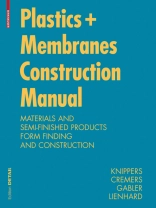Whether it be as translucent sheets, broadly stretched membranes, and inflated foil cushions or in graceful, organic curves, architecture today is utilizing plastics in the most disparate forms and for a wide variety of purposes. Innovative technical developments are constantly improving its material properties; at the same time, there is a growing new awareness of its potential as a construction material. While plastics used to be employed primarily as an inexpensive variant on traditional building materials, they are increasingly regarded in the construction world today as a serious and viable alternative, be it as supporting structures, roofs, facades, or elements of interior design and decoration. Thanks in large part to this inherent self-sufficiency, plastics are currently enjoying an unprecedented surge in popularity, even among the international architectural avant-garde – as multiwall sheets or corrugated, fiber-reinforced panels, or as filling between glass panes. And the new generation of ecological bioplastics also pays tribute to the debate on sustainability, ridding plastics of their lingering reputation as environmental offenders.
From the history of plastics and membranes in architecture to their material properties and requirements in construction and design, the Plastics and Membranes Construction Manual cuts to the chase, providing the kind of solid and comprehensive overview of the subject that readers have come to expect from the Im DETAIL series. Selected project examples round off the reference work and make it indispensable for the day-to-day life of the professional planner and for every architecture library.
Содержание
Atlas Kunststoffe und Membranen
Inhalt
Vorwort
Teil A Kunststoffe und Membranen in der Architektur
Die Entdeckung und Entwicklung von Kunststoffen
Der Traum vom Kunststoffhaus
Entwicklung des Membranbaus
Bauten mit transparenten und transluzenten Hüllen
Potenziale, Tendenzen und Herausforderungen
Teil B Werkstoffe
1 Kunststoffe
2 Fasern
3 Klebstoffe und Beschichtungen
4 Naturfaserverstärkte Kunststoffe und Biokunststoffe
Teil C Halbzeuge
1 Vorprodukte
2 Faserverstärkte Kunststoffe
3 Kunststoffhalbzeuge
4 Folien
5 Textile Membranen
6 Erweiterte bauphysikalische und energetische Aspekte
7 Umweltwirkungen von Kunststoffen
Teil D Planung und Formfindung
1 Tragwerk und Form
2 Dimensionierung und Ausführung
Teil E Konstruieren mit Kunststoffen und Membranen
1 Konstruieren mit Kunststoffhalbzeugen
2 Konstruieren mit frei geformten Kunststoffen
3 Konstruieren mit Folien
4 Konstruieren mit textilen Membranen
5 Komplexe Gebäudehüllen
Teil F Gebaute Beispiele im Detail
Projektbeispiele 1 bis 23
Teil G Anhang
Verordnungen, Richtlinien, Normen
Literatur / Autoren
Autoren
Abbildungsnachweis
Sachregister
Personenregister
Об авторе
Jan Knippers, Prof. Dr.-Ing., Institut für Tragkonstruktionen und Konstruktives Entwerfen (itke), Fakultät für Architektur und Stadtplanung, Universität Stuttgart
Jan Cremers, Prof. Dr.-Ing. Architekt, Fakultät Architektur und Gestaltung, Hochschule für Technik Stuttgart
Markus Gabler, Dipl.-Ing., Institut für Tragkonstruktionen und Konstruktives Entwerfen (itke), Fakultät für Architektur und Stadtplanung, Universität Stuttgart
Julian Lienhard, Dipl.-Ing., Institut für Tragkonstruktionen und Konstruktives Entwerfen (itke), Fakultät für Architektur und Stadtplanung, Universität Stuttgart












